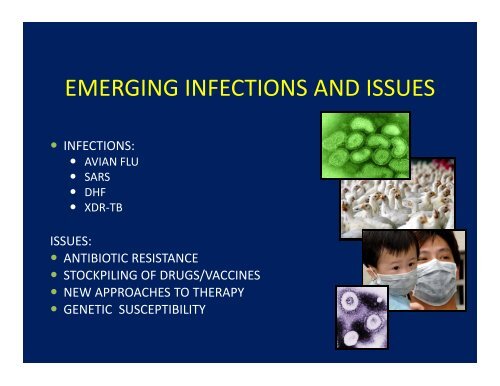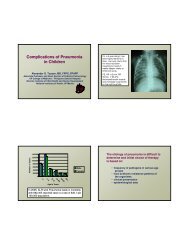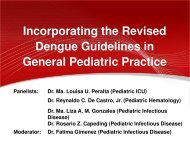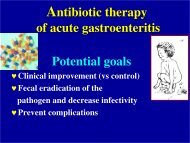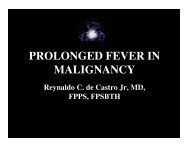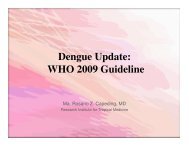Download PDF - Pediatric Infectious Disease Society of the ...
Download PDF - Pediatric Infectious Disease Society of the ...
Download PDF - Pediatric Infectious Disease Society of the ...
Create successful ePaper yourself
Turn your PDF publications into a flip-book with our unique Google optimized e-Paper software.
EMERGING INFECTIONS AND ISSUES<br />
INFECTIONS:<br />
AVIAN FLU<br />
SARS<br />
DHF<br />
XDR-TB<br />
ISSUES:<br />
ANTIBIOTIC RESISTANCE<br />
STOCKPILING OF DRUGS/VACCINES<br />
NEW APPROACHES TO THERAPY<br />
GENETIC SUSCEPTIBILITY
“The global future <strong>of</strong> mankind<br />
will probably unfold as<br />
episodes<br />
<strong>of</strong> a suspense thriller<br />
that could be entitled,<br />
“Our Wits Versus Their Genes.”<br />
- Joshua<br />
Lederberg
EMERGING INFECTIONS IN<br />
PEDIATRICS: PHILIPPINE EXPERIENCE<br />
PROF LULU C BRAVO, MD<br />
UNIVERSITY OF THE PHILIPPINES<br />
MANILA
EMERGING DISEASES: DEFINITIONS<br />
• Has increased in <strong>the</strong> past 20 years<br />
• Comprise at least 12 % <strong>of</strong> infections<br />
• Types are:<br />
-newly identified organism or a new strain<br />
eg. SARS, AIDS<br />
-change due to evolution<br />
eg. Influenza H1N1
-Known infection identified in a new location<br />
eg. Japanese B encephalitis<br />
- New infection in an area undergoing ecologic<br />
transformation<br />
eg. Lyme disease<br />
-Pre-existing disease re-emerging as drugresistant<br />
eg. MDRTB
MECHANISMS OF EMERGENCE AND<br />
RE-EMERGENCE<br />
• Microbial adaption; e.g. genetic drift and<br />
genetic shift in Influenza A<br />
• Changing human susceptibility; e.g. mass<br />
immunocompromisation with HIV/AIDS<br />
• Climate and wea<strong>the</strong>r; e.g. diseases with<br />
zoonotic vectors such as Dengue (transmitted<br />
by mosquitoes) are moving fur<strong>the</strong>r from <strong>the</strong><br />
tropics as <strong>the</strong> climate warms
• Change in human demographics and trade;<br />
e.g. rapid travel enabled SARS to rapidly<br />
propagate around <strong>the</strong> globe<br />
• Economic development; e.g. use <strong>of</strong> antibiotics<br />
to increase meat yield <strong>of</strong> farmed cows leads to<br />
antibiotic resistance<br />
• Breakdown <strong>of</strong> public health; e.g. <strong>the</strong> current<br />
situation with Measles
• Poverty and social inequality; e.g. tuberculosis<br />
is primarily a problem in low-income areas<br />
• War and famine<br />
• Bioterrorism; e.g. 2001 Anthrax attacks<br />
• Dam and irrigation system construction; e.g.<br />
malaria and o<strong>the</strong>r mosquito borne diseases
THE GLOBAL CHALLENGE<br />
The Global Village<br />
Global “microbial traffic”<br />
GLOBALIZATION OF HEALTH / DISEASE
Global Burden <strong>of</strong> <strong>Infectious</strong> <strong>Disease</strong>s<br />
Figure from Morrens et al, Nature Vol 430 July 2004<br />
Leading cause <strong>of</strong> death worldwide: About 15 million (>25%) <strong>of</strong> 57<br />
million worldwide are <strong>the</strong> direct result <strong>of</strong> infectious diseases<br />
-WHO Report 2004
Figure from Morrens et al, Nature Vol 430 July 2004<br />
Global examples <strong>of</strong> emerging and re-emerging infectious diseases.<br />
Red represents newly emerging diseases; Blue, re-emerging<br />
diseases; Black, a ‘deliberately emerging’ disease
THE PHILIPPINE SITUATION<br />
… THE VIRUSES<br />
….THE BACTERIA<br />
…. THE PARASITES<br />
AND OTHERS...
Japanese B Encephalitis<br />
SENTINEL SURVEILLANCE ON ETIOLOGY OF<br />
MENINGITIS ENCEPHALITIS AND MENINGO-<br />
ENCEPHALITIS IN THE PHILIPPINES<br />
A TECHNICAL PROGRESS REPORT<br />
SEPTEMBER TO DECEMBER 2010<br />
ESPINO, FE et al...<br />
Research Institute <strong>of</strong> Tropical Medicine
Distribution <strong>of</strong> Japanese B Encephalitis by age group<br />
(January to December 2010)- From sentinel hospitals<br />
during a 22 month period<br />
Age Group in Years Total Number <strong>of</strong> specimens Japanese Encephalitis (%)<br />
Neonate-< 2 months 31 0<br />
2 months-
Distribution <strong>of</strong> Japanese B Encephalitis by Age<br />
Group (January to December 2010)- From sentinel<br />
hospitals during a 22-month period
Frequency <strong>of</strong> Japanese B Encephalitis cases by Hospital<br />
(January to December 2010)<br />
Results BuMC (%)<br />
n=49<br />
BiMC (<br />
%)<br />
n=37<br />
WVMC (%)<br />
n=50<br />
TPH (%)<br />
n=30<br />
PCMC (%)<br />
n=1<br />
Total (%)<br />
n=167<br />
JE<br />
6 14 5 7 (23.3%) 0 32<br />
Positive (12.2%) (37.8%) (10%) (19.2%)<br />
1<br />
Bulacan Medical Center<br />
2<br />
Bicol Medical Center<br />
3<br />
Western Visayas Medical Center<br />
4<br />
Tarlac Provincial Hospital<br />
5<br />
Philippine Children’s Medical Center
Distribution <strong>of</strong> Sentinel Hospitals for Japanese Encephalitis<br />
Tarlac<br />
Bulacan<br />
Bicol<br />
PCMC<br />
Visayas
Japanese Encephalitis in <strong>the</strong> Philippines<br />
1991<br />
1. Dagupan City (Luzon) reported 4 deaths<br />
from encephalitis<br />
13 hospitalized cases identified as<br />
encephalitis<br />
5 deaths confirmed<br />
(45% fatality rate)<br />
5 from different<br />
barangays discharged & improved at time<br />
<strong>of</strong> investigation
Japanese Encephalitis in <strong>the</strong> Philippines<br />
2. Pigcawayan at North Cotabato<br />
Review <strong>of</strong> Records Jun-July 1991 at<br />
Cotabato Regional Hospital<br />
• 40 CNS infections identified<br />
8 JE cases suspected from<br />
Pigcawayan (confirmation not<br />
reported)
Japanese Encephalitis in <strong>the</strong> Philippines<br />
Characteristic neurologic features for JEV<br />
• Abulia with masked facies<br />
• Variable changes in mentation<br />
• Relative absence <strong>of</strong> cranial nerve<br />
involvement<br />
• Lack <strong>of</strong> gross sensory deficit<br />
• Asymmetric and irregular distribution <strong>of</strong><br />
motor and tone abnormality
Japanese Encephalitis in <strong>the</strong> Philippines<br />
Among Clinically Diagnosed Dengue<br />
Cases in 1999<br />
• 6% (46/770) were positive for JE<br />
• 0.8% (6/770) had co-infections <strong>of</strong><br />
Chikungunya & JE
Japanese Encephalitis in <strong>the</strong> Philippines<br />
Among Clinically Diagnosed Dengue<br />
Cases in 1999<br />
• 6% (46/770) were positive for JE<br />
• 0.8% (6/770) had co-infections <strong>of</strong><br />
Chikungunya & JE
Japanese Encephalitis in <strong>the</strong> Philippines<br />
NOTIFIABLE<br />
DISEASES, 2001<br />
No.<br />
Rate/100,000 pop<br />
Encephalitis /<br />
207 0.3<br />
Meningitis<br />
Meningococcemia 57 0.1<br />
Dengue 23,235 29.8<br />
Diarrhea 845,526 1085.0
Japanese Encephalitis in <strong>the</strong> Philippines<br />
NOTIFIABLE<br />
DISEASES, 2008<br />
No.<br />
Rate/100,000 pop<br />
Encephalitis /<br />
788 0.9<br />
Meningitis<br />
Meningococcemia 17 0.0<br />
Dengue 13,014 14.5<br />
Diarrhea 434,445 485.4
DENGUE<br />
• Number <strong>of</strong> cases nationwide from January to Dec<br />
2010 135,355<br />
– 134.84% higher compared to <strong>the</strong> same period<br />
last year (57,636)<br />
• Patients’ ages ranged between less than 1 month<br />
- 95 years old<br />
– 78% belong to <strong>the</strong> 1-20 years age group<br />
– More deaths recorded in those below one year and in<br />
<strong>the</strong> 1-10 years age groups<br />
– Males comprised 52%<br />
www.doh.gov.ph
DENGUE<br />
• Total <strong>of</strong> 793 deaths recorded for <strong>the</strong><br />
period case fatality rate <strong>of</strong> 0.59%<br />
which decreased by 40% from 2009<br />
• Reported cases with highest CFR<br />
are in region IX and ARMM<br />
• Lowest CFR was found in CAR<br />
www.doh.gov.ph
MENINGOCOCCAL DISEASE
HIV- AIDS<br />
l
HIV- AIDS
300 cases per 100,000<br />
WHO<br />
REGIONS<br />
Estimated TB incidence and mortality, 2002 (WHO)<br />
Number <strong>of</strong> cases<br />
(thousands)<br />
All<br />
Forms<br />
(%)<br />
Cases per<br />
100,000<br />
population<br />
All<br />
forms<br />
Smear-<br />
positive<br />
Smear-<br />
positive<br />
Deaths from TB (including<br />
TB deaths in people<br />
infected with HIV)<br />
Number<br />
(thousands)<br />
Per 100 000<br />
population<br />
Africa<br />
2354<br />
(26)<br />
The<br />
370<br />
Americas (4)<br />
Eastern<br />
Mediterran<br />
ean<br />
Europe<br />
South-East<br />
Asia<br />
Western<br />
Pacific<br />
Global<br />
622<br />
(7)<br />
472<br />
(5)<br />
2890<br />
(33)<br />
2090<br />
(24)<br />
8797<br />
(100)<br />
1000 350 149 556 83<br />
165 43 19 53 6<br />
279 124 55 143 28<br />
211 54 24 73 8<br />
1294 182 81 625 39<br />
939 122 55 373 22<br />
3887 141 63 1823 29
TB<br />
<br />
HIV-<br />
uninfected<br />
areas<br />
HIV-<br />
infected<br />
areas<br />
High impact on countries with<br />
HIV infections due to<br />
considerable overlap between<br />
clinical pictures caused by TB<br />
and HIV-related lung disease
TB<br />
HIV<br />
HIV status <strong>of</strong>ten “unknown” in children<br />
suspected with TB<br />
Thus:<br />
important to do HIV<br />
testing for more<br />
appropriate treatment<br />
and prophylaxis
Multidrug-Resistant (MDR) TB<br />
• MDR-TB is as infectious as drug susceptible<br />
TB<br />
• Diagnosis is confused by lack <strong>of</strong> culture and<br />
susceptibility testing<br />
• Suspected if:<br />
– an adult index case has MDR-TB<br />
– child is a treatment failure despite compliant <strong>the</strong>rapy<br />
– <strong>the</strong> adult index case has unknown susceptible testing and<br />
with treatment failure or a retreatment case
NEGLECTED FOOD-BORNE<br />
DISEASES
Prevalence<br />
Philippines<br />
Rate<br />
Bangladesh<br />
Cryptosporidium 8.9% Menorca M, et al.<br />
SEAJTM 1994<br />
By EIA<br />
8.4% Haque, R et al.<br />
AJTMH 2003<br />
2.5% Paje-Villar E, et al.<br />
Ann Trop Med<br />
Parasitol<br />
1994<br />
By Microscopy<br />
G. lamblia 0.6% Adkins HJ, et al.,<br />
JCM 1987, Method (?)<br />
11% Haque, R et al.<br />
AJTMH 2003<br />
E. histolytica 0.1% Adkins HJ, et al.,<br />
JCM 1987, Method (?)<br />
8% Haque, R et al.<br />
AJTMH 2003
Disruption <strong>of</strong> intestinal barrier function<br />
in HIV-infected patients with and without<br />
diarrhea in Fortaleza, Brazil<br />
0.25<br />
P < 0.01<br />
0.2<br />
Lactulose /<br />
Mannitol<br />
Ratio<br />
0.15<br />
0.1<br />
P < 0.01<br />
0.05<br />
0<br />
Healthy<br />
Controls<br />
(n = 13)<br />
HIV+<br />
Non-diarrhea<br />
(n = 19)<br />
HIV+<br />
Diarrhea<br />
(n = 19)<br />
Lima et al. AJGastro. 92:1861, 1997
Disruption <strong>of</strong> Intestinal Barrier Function in Children<br />
with Cryptosporidial and non-Cryptosporidial<br />
Diarrhea in Fortaleza, Brazil<br />
0.7<br />
*<br />
0.6<br />
0.5<br />
**<br />
Mean<br />
Lactulose:<br />
Mannitol<br />
Excretion<br />
Ratios<br />
0.4<br />
0.3<br />
0.2<br />
0.1<br />
0<br />
[vs controls: *p=0.001; **p
Intestinal Barrier Disruption in HIV-infected patients with<br />
cryptosporidial, non-cryptosporidial, and<br />
microsporidial diarrhea<br />
Lactulose /<br />
Mannitol<br />
P < 0.001<br />
0.4<br />
P = 0.02<br />
0.35<br />
0.3<br />
0.25<br />
Ratio 0.2<br />
P = 0.008<br />
0.15<br />
0.1<br />
0.05<br />
0<br />
No Diarrhea Non Crypto Crypto<br />
N = 19<br />
Diarrhea Diarrhea<br />
N = 14 N = 4<br />
Microsporidia<br />
N = 1<br />
Lima et al. Am J Gastro. 92:1861, 1997.
Cryptosporidiosis<br />
• Causal Agent<br />
– Many species <strong>of</strong> Cryptosporidium exist that infect<br />
humans and a wide range <strong>of</strong> animals<br />
– C. parvum and C. hominis (formerly known as C. parvum<br />
anthroponotic genotype or genotype 1) are <strong>the</strong> most<br />
prevalent species causing disease in humans
Clinical Features<br />
• Wide range <strong>of</strong> manifestation<br />
– Asymptomatic to severe life-threatening illness<br />
– Watery diarrhea is <strong>the</strong> most frequent symptoms<br />
– Dehydration, weight loss, abdominal pain<br />
– Fever<br />
– Nausea<br />
– Vomiting
Cyclosporiasis<br />
• Recently identified as a unicellular coccidian<br />
parasite<br />
• Causal agent: Cyclospora cayetanensis<br />
• Designation given in 1994 to Peruvian isolates<br />
<strong>of</strong> human-associated Cyclospora<br />
• Appears that all human cases are caused by<br />
this species
Clinical Features<br />
• Incubation period: 1 week<br />
• Symptomatic infections<br />
– Watery diarrhea, which can be severe<br />
– Anorexia<br />
– Weight loss<br />
– Abdominal pain<br />
– Nausea and vomiting<br />
• Untreated infections typically lasts for 10-12 weeks<br />
and may follow a relapsing course
Laboratory Diagnosis<br />
Specimen processing<br />
– Fixed in 10% formalin<br />
• Direct microscopy<br />
• Concentration procedure<br />
• Preparation <strong>of</strong> stained smears<br />
– Fixed in 2.5% potassium dichromate<br />
• For sporulation assay and molecular diagnosis<br />
– Frozen without fixation<br />
• For molecular diagnosis
Microsporidiosis<br />
• Causal agents<br />
– 14 microsporidian species<br />
• Enterocytozoon bieneusi<br />
• Encephalitozoon intestinalis<br />
• Encephalitozoon hellem<br />
• Encephalitozoon cuniculi<br />
• Pleistophora sp.<br />
• Trachipleistophora hominis<br />
• T. anthropophtera<br />
• Nosema ocularum<br />
• N. algerae<br />
• Vittaforma corneae<br />
• Microsporidium ceylonensis<br />
• M. africanum<br />
• Brachiola vesicularum<br />
• B. connori<br />
• Increasingly recognized as opportunistic infectious agent worldwide
Clinical Features<br />
• Represents an important and rapidly emerging<br />
opportunistic disease<br />
• Occurring mainly, but not exclusively, in<br />
severely immunocompromised patients with<br />
AIDS<br />
• Cases <strong>of</strong> microsporidiosis in<br />
immunocompromised persons not infected<br />
with HIV as well as in immunocompetent<br />
persons also have been reported
Laboratory Diagnosis<br />
• Light Microscopy<br />
– Chromotrope 2R method<br />
• Transmission electron Microscopy<br />
• Immun<strong>of</strong>luorescence Assay<br />
• Molecular Methods
THE CHALLENGE FOR EMERGING<br />
DISEASES<br />
• Need for Surveillance and Accurate<br />
Reporting<br />
• Appropriate Laboratory procedures for<br />
Identification<br />
• Networking<br />
• Rapid Response In Outbreak Situations<br />
• Control Measures in Place
REMAINING CHALLENGES AND<br />
ISSUES<br />
VECTOR CONTROL<br />
– MALARIA<br />
– JAP B ENCEPHALITIS<br />
– DENGUE<br />
MASS DRUG ADMINISTRATION<br />
– SCHISTOSOMIASIS<br />
– FILARIASIS<br />
– OTHER NEGLECTED DISEASES
InterAcademy Network for<br />
Emerging Infections (IANEI)<br />
• UP MANILA- NIH AND NAST ENDEAVORS<br />
TO ESTABLISH A NETWORK FOR<br />
EMERGING INFECTIONS IN THE<br />
PHILIPPINES AND ASIA.
The IANEI aims to achieve <strong>the</strong><br />
following objectives<br />
1. To facilitate communication between<br />
academies <strong>of</strong> medicine and medical<br />
sciences on issues related to<br />
emerging infections<br />
2. To develop and maintain a database <strong>of</strong><br />
researches and programmes on <strong>the</strong><br />
emerging infections
Objectives<br />
IANEI<br />
3.To provide evidence-based recommendations for<br />
health policy development for <strong>the</strong> control <strong>of</strong><br />
emerging infections<br />
4.To encourage collaboration between academies <strong>of</strong><br />
medicine and medical sciences on researches and<br />
programmes on <strong>the</strong> control <strong>of</strong> emerging infections<br />
5.To mobilize support for researches that would<br />
provide new knowledge crucial to increasing <strong>the</strong><br />
effectiveness <strong>of</strong> control programmes for emerging<br />
infections
“If history is our guide, we can assume<br />
that <strong>the</strong> battle between <strong>the</strong> intellect<br />
and will <strong>of</strong> <strong>the</strong> human species and <strong>the</strong><br />
extraordinary adaptability <strong>of</strong> microbes<br />
will be never-ending. To successfully<br />
fight our microbial foes, we must<br />
continue to vigorously pursue<br />
research on <strong>the</strong> basic mechanisms<br />
that underlie microbial pathogenesis<br />
and develop novel strategies to outwit<br />
<strong>the</strong>se ingenious opponents. The past<br />
10 years have been challenging but no<br />
more so than will be <strong>the</strong> future.”<br />
- Steven A Fauci, EID 2005


